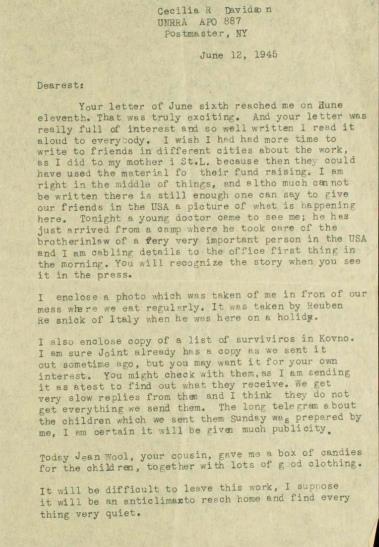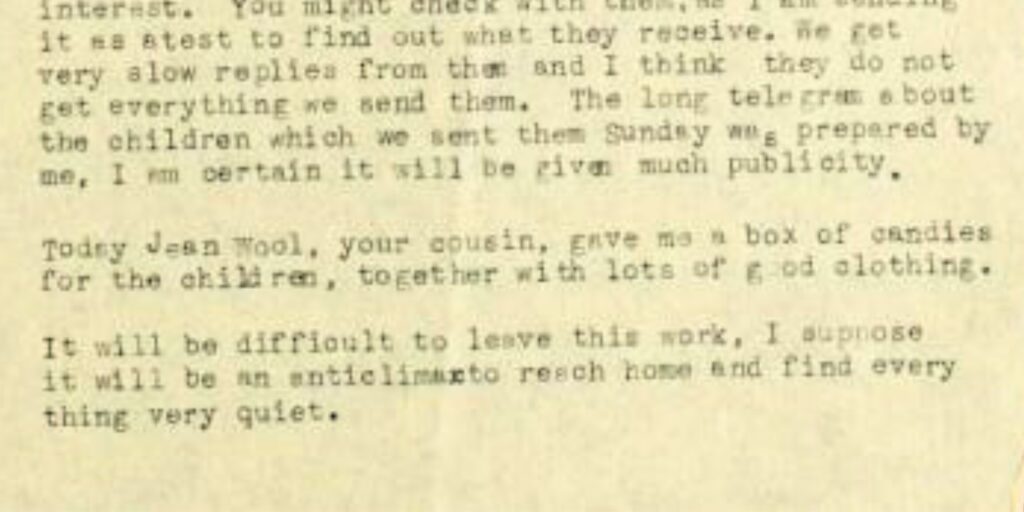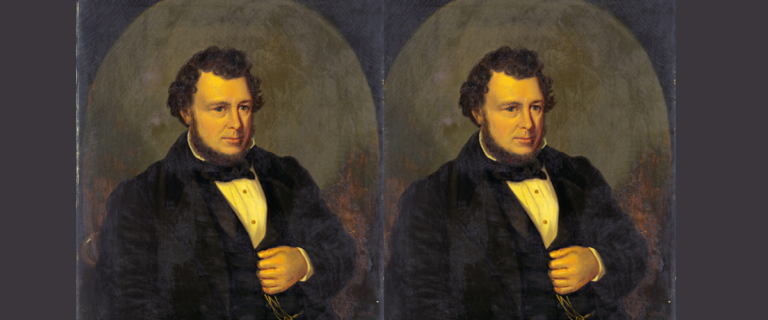Cecilia Razovsky is one of the most interesting and least known figures in the history of Jewish immigration. Her career as a refugee relief worker was extensive, spanning from the early 1910s through the 1960s. Her love and compassion for refugees and immigrants came from her childhood experiences in St. Louis; her parents, along with most of their neighbors, were Jewish immigrants who had escaped the spread of pogroms and antisemitic legislation in Russia.
Born in 1891, Razovsky began working odd jobs at the age of 12 to support her family. When she turned 18, she began working for the Jewish Educational Alliance, teaching English and History to immigrants at night and Hebrew to children on the weekends. Afterwards, she worked for the St. Louis Board of Education and the Child Labor Division in Washington, DC, where she studied the effects of World War I on child labor and on school attendance throughout the United States and surveyed the enforcement of child labor laws in the District.
In 1921, her work with immigrants resumed. Razovsky began working for the National Council of Jewish Women (NCJW), becoming Associate Director within a year. While at the NCJW, she worked on assisting immigrants in adjusting to their new homes and working to create legislation to make those transitions easier. Her work took her all over the United States, including to Ellis Island in New York to personally welcome immigrants.

Throughout the 1920s, Razovsky wrote plays, articles, stories, and more. She drew inspiration for a large part of her writings from her time at Ellis Island, including a play aptly titled At Ellis Island in 1922 and an article published in 1920. In her article, Razovsky writes that despite “their homes in ruin, dear ones overtaken by death,” these new immigrants’ “spirit remained unbroken, and their faith in the future unshaken.” Razovsky also authored two books, What Every Emigrant Should Know (1922) and What Every Woman Should Know About Citizenship (1926).
By 1934, Razovsky had served as the chair of 8 committees, worked in Russia, Cuba, Germany, Switzerland, and New York, and attended major legislative conferences concerning immigration from 1924 to 1933, somehow finding time to marry Morris Davidson in 1927. In 1935, she started as Executive Director at the newly created National Coordinating Committee (NCC), an organization created the year before to assist the influx of German refugees, both Jewish and non-Jewish, in entering the United States. In this capacity, Razovsky coordinated the work of relief organizations, raised awareness of refugee needs, and much more.
After Kristallnacht, or the Night of Broken Glass, in 1938, the NCC was flooded with around 1,300 calls a day from German Jews trying to escape the Nazi regime. The sheer number of refugees needing assistance and affidavits to come to America is documented in the hundreds of letters and documents Razovsky authored in the last two months of 1938; each one concerning a new individual or family needing a way to escape Germany. The new workload caused the NCC to merge with two other organizations in 1939 to create the National Refugee Service (NRS), for which Razovsky served as the assistant to the Executive Director.

In 1945, Razovsky was working for the United Nations Relief and Rehabilitation Administration (UNRRA), which loaned her out to the American Jewish Joint Distribution Committee (AJDC) in Paris. The Allies had just liberated Buchenwald and the US military had begun to set up Displaced Persons, or DP, camps in France.
Despite the horrific conditions in the DP camps, Razovsky lived on-site, arranging visas for the children released from Buchenwald and even accompanying them to temporary care units in France and Switzerland. By the end of 1945, Razovsky was suffering from the impact of DP camp conditions. She moved to Germany and began creating emigration offices and organizing the boats that were carrying refugees to the United States.


In 1957, Razovsky turned her attention from Europe and the United States to Brazil as a new destination for Jewish refugees, following a trip there with her husband in 1946. Despite being 70 and at the normal age of retirement, Razovsky began working for the Hebrew Immigrant Aid Society Service (HIAS) to, in part, help small Jewish communities in Brazil to absorb refugees from Egypt and Hungary. Her correspondence reflects the challenges refugees encountered in adjusting to various living standards.

Razovsky and her husband gathered information for HIAS on other Latin American countries, including Costa Rica, Guatemala, Paraguay, Panama, and Chile, as possible homes for Jewish refugees. Their last stop was Mexico City, where Razovsky found that the Jewish leaders living there were so well-situated that they were barely concerned with the fate of Jews in other countries, a sharp contrast from the other places she had seen.
In her final years, Razovsky remained remarkably active, continuing to travel around Latin America before finally settling in San Diego, California in 1964. Her last major work was a manuscript titled Forty Thousand New Brazilians, written in 1964, which was a conglomeration of her notes on the Jewish community in Brazil encompassing from 1937 to 1963. In the last year of her life, she served as Chairman of the International Committee for Social Work in San Diego. She had also started to create an agency to aid Mexican American immigrants.

Razovsky died on September 27, 1968, at the age of 81. Her career was illustrious, spanning over 50 years and taking her all over the world. She devoted her entire life to protecting and acclimating refugees, and personally oversaw the escape voyages of thousands of people. Her career is as one of deep altruism and intrinsic motivation.
Listen to episode 5 of our podcast The Wreckage, to learn more about Cecilia Razovsky.



